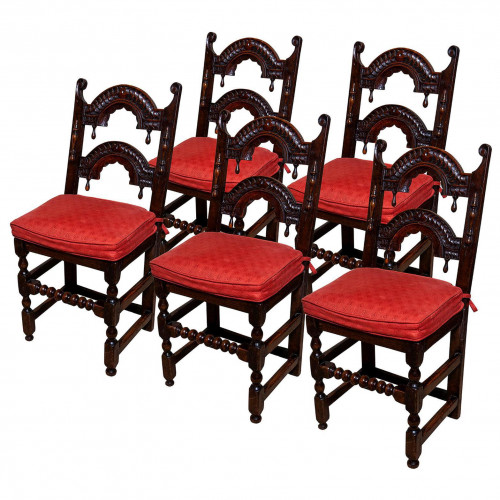Chairs Set Four 4 Walnut Carved Marot 18 Century Silk Damask Yellow Upholstered
11625
- Chairs of this calibre rarely come onto the open market. These are of the type that one sees either illustrated in classic reference books, or standing in grand country houses and stately homes, such as Knowle, Ham House and Penshurst Place. They are usually placed in symmetrical groups against the walls in reception rooms when not in use.
- They have magnificently carved backs, crestings and stretchers which can be seen to full advantage creating an arresting visual display if, as was traditional, they are positioned against a wall when not in use. These chairs are typical of the more elaborately, carved chairs which recall the designs of Daniel Marot who spent some years in England in the service of the King. Although they copied continental designs, many were doubtless made in England by immigrant craftsmen.
- It is also very unusual for chairs of this type to be upholstered in a contemporary textile, in this case early-18th century, gold brocatelle and shaped gold fringe.
- Although chairs with scrolled front legs continued to be made, in about 1690 vertical forms became fashionable. The cappings are often pear or mushroom-shaped carved with gadroons and below is a turned section tapered to a rectangular block above an octagonal or spherical foot. Sometimes the leg is enriched with mouldings, while small, sunk panels are found on the square sections. The stretchers on such chairs are not attached midway to the front legs but set back and tenoned into the side stretchers at a lower level.
- They have come from a private collection and one chair retains an old 'Phillips of Hitchen' label.
The shaped crestings are elaborately carved with acanthus leaves and scrollwork around a central cartouche which was probably originally painted with a coat of arms. The backs with central uprights finely, carved with strapwork, acanthus leaves, scrolls and shell motifs bordered with reeded oval cartouches. These are flanked by reeded uprights terminating in classical columns and baluster turned uprights. The stuff-over seats upholstered in early-18th century, gold brocatelle and shaped, gold fringe. The front legs are turned with a mushroom capping above a tapering section on faceted blocks decorated with carved leaves. The back legs have a slight rake, and mushroom and baluster turnings. Standing on original bun feet. The front stretchers are elaborately carved with central urns amongst scrolls and floral motifs. Exceptional original colour and patina.
18th Century
circa 1720
Walnut
England
Collectors
Baroque (Of the period)
Hand-Carved
Commemorative
GOOD. Wear consistent with age and use.
4




























